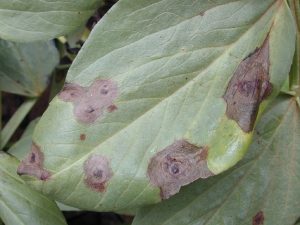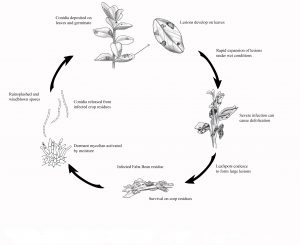Cercospora is caused by the fungal pathogen Cercospora zonata. This disease can cause problems in some years. The disease often occurs when plants are grown in wet patches, particularly where free water remains on the soil surface. The effect on yield has shown to be in the magnitude of 5-10 per cent under high disease pressure.
What to Look For
Cercospora zonata mainly affects leaves, but may also affect stems and pods of faba beans. Lesions initially form on lower leaves of the seedling, early in the growing season, then expand resulting in severe blighting of the leaf. Dark irregular lesions form which may be difficult to distinguish from ascochyta blight. However, lesions of cercospora tend to be darker and their shape is more irregular. Within the spots a concentric ring pattern can often be seen. The disease spreads to upper foliage if conditions favour disease development. Severe infection can result in extensive defoliation of plants and lesions on pods.

Cercospora leaf spots tend to be darker than those of chocolate spot with irregular shaped edges. A ring pattern may also develop. Unlike ascochyta, no pycnidia are produced.
Disease Cycle
Cercospora originates from soil-borne inoculum and previously infected plant material. It is spread during the season by conidia that dislodge from short white spore clumps on the surface of lesions.
Management
Cercospora leaf spot is often confused with ascochyta blight and chocolate spot. Fungicide control may be warranted in some years.



